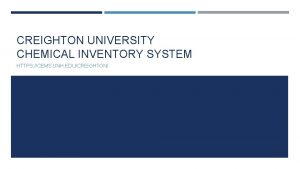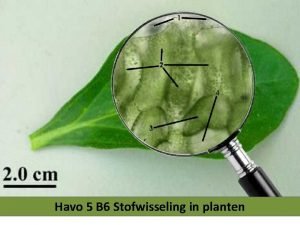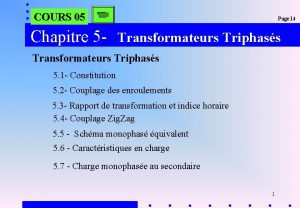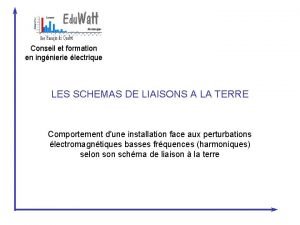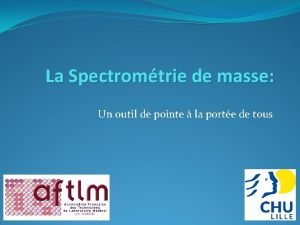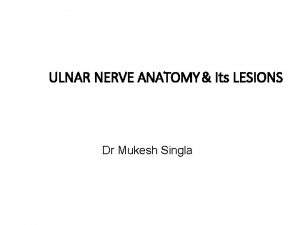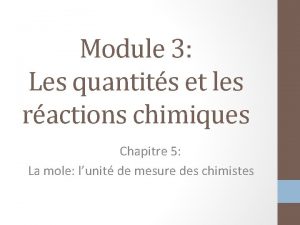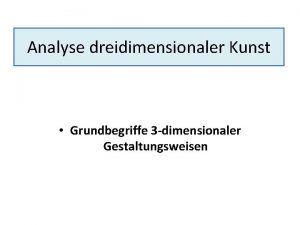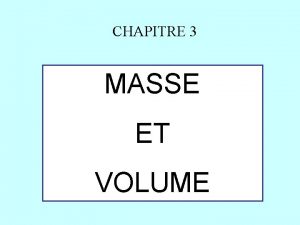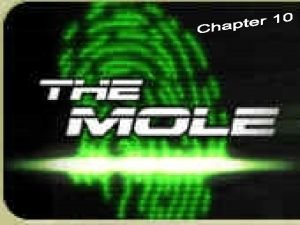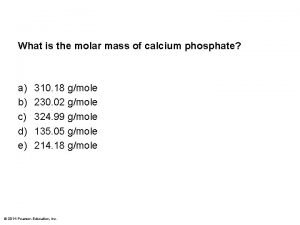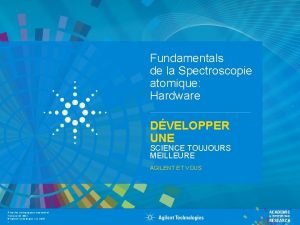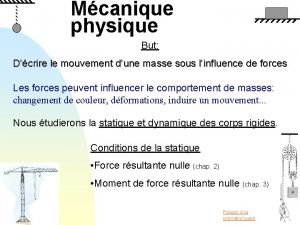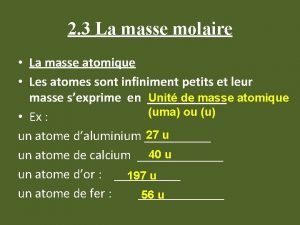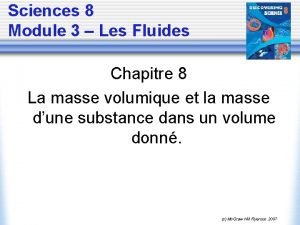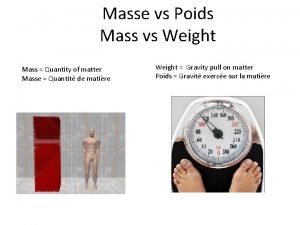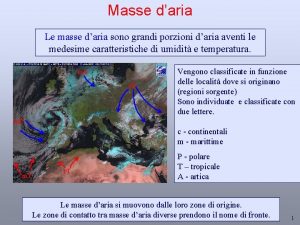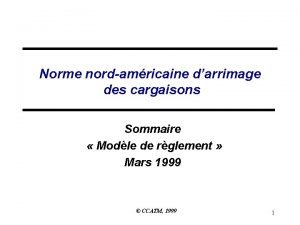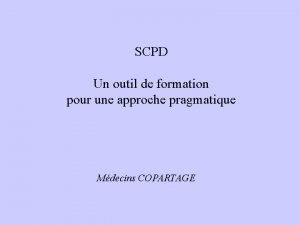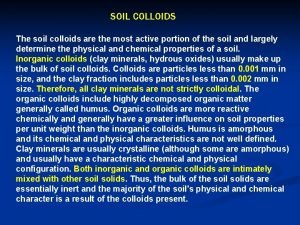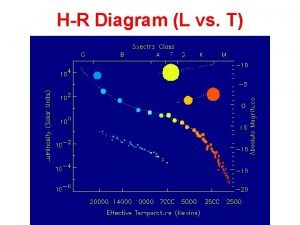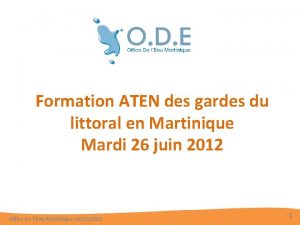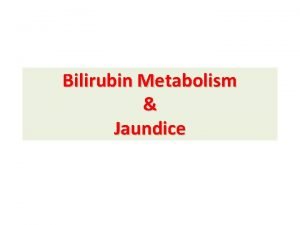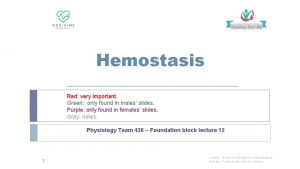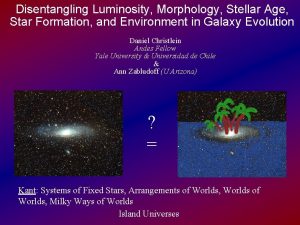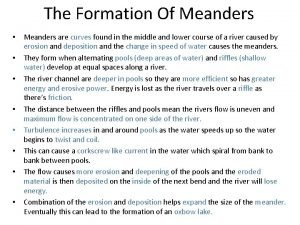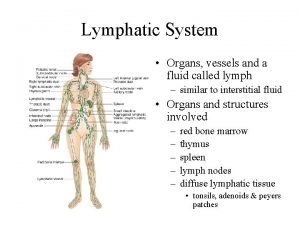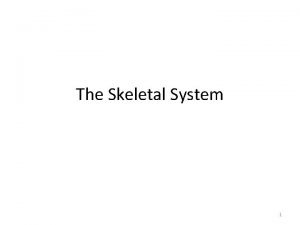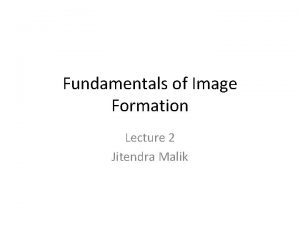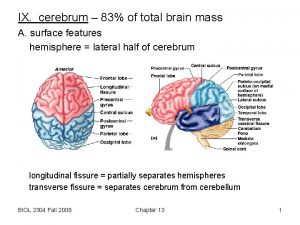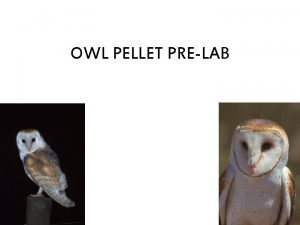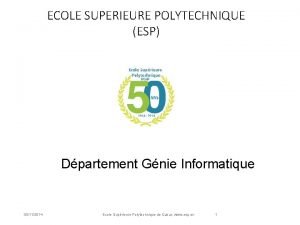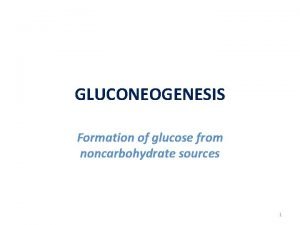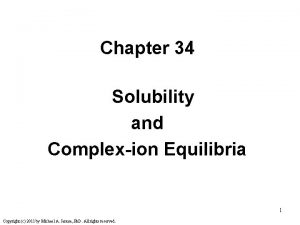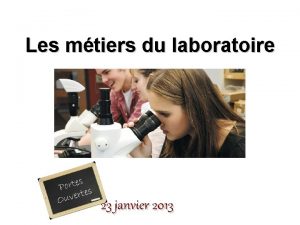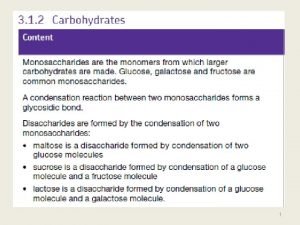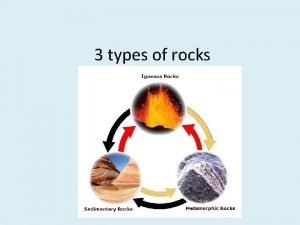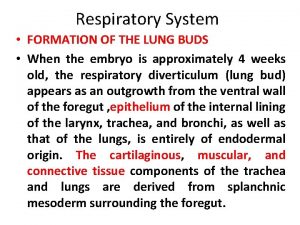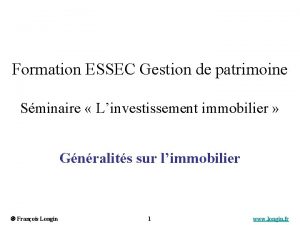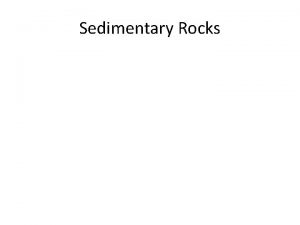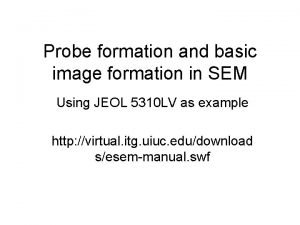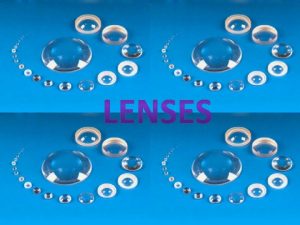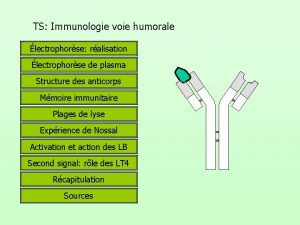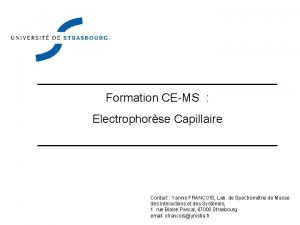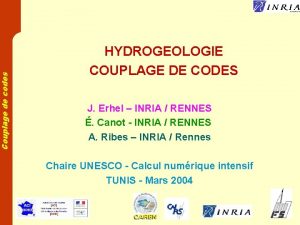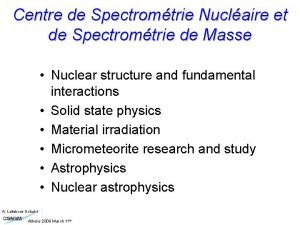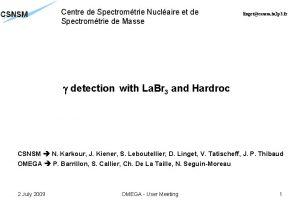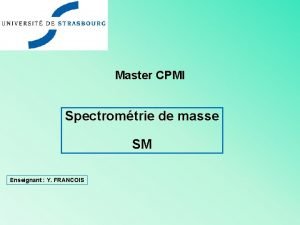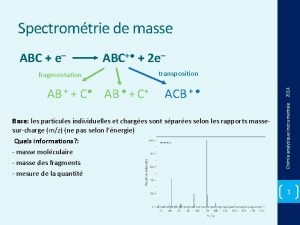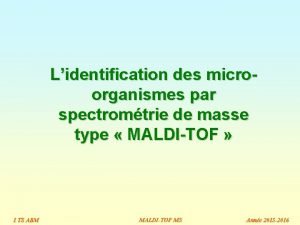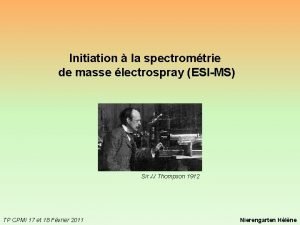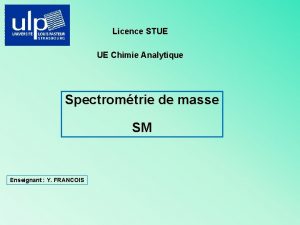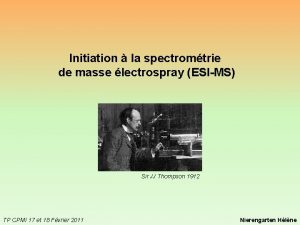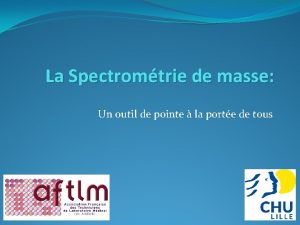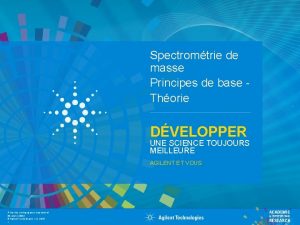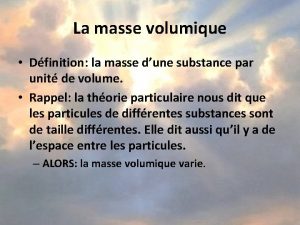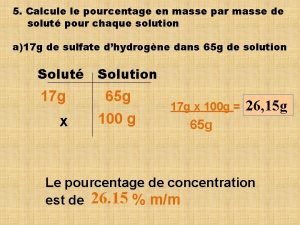Formation CEMS Couplage lectrophorse capillaire spectromtrie de masse





























































































































- Slides: 125

Formation CE-MS : Couplage électrophorèse capillaire- spectrométrie de masse (CE-MS) Contact : Yannis FRANCOIS, Lab. de Spectrométrie de Masse des Interactions et des Systèmes 1 rue Blaise Pascal, 67000 Strasbourg email: yfrancois@unistra. fr

DETECTION LES PLUS COURANTS: détection UV détection par fluorescence détection par spectrométrie de masse Détection OFF-COLONNE Détection ON-COLONNE + -

OFF-COLONNE Détection par spectrométrie de masse nécessite de concevoir une interface adaptée assurer le maintien du champ électrique diminuer les effets d’aspiration utiliser des analyseurs permettant des scans rapides Interface basée sur le mode ESI/MS appliquée aux sels d’ammonium, amines, dipeptides ex : pour les ions simples, LOD = 10 amol

Number of publications CE–MS Coupling Web of science. SM search using term “capillary electrophoresis and mass spectrometry”

Couplage CE-MS Advantages CE-MS Bonne efficacité Ultra-low flow rate Selectivité Sensibilité Information de structure Inconvénients CE-MS Faible volume d’échatillon (haute concentration) Compatibilité du BGE avec la MS Adsorption protéine surface interne Difficulté pour maintenir le courant

Les réponses aux limitations I Adsorption des protéines à la surface interne du capillaire Greffage des parois internes du capillaire. üCovalent (idéal pour MS) üDynamique (compatible MS) Exemple Répétition d’analyse CE-UV d’une solution d’hormone de croissance (3 mg/m. L). (A) Capillaire Viège § Baisse de l’eof § Baisse de la résolution (B) Capillaire greffé PB-PVS § RSD=0, 68% (n=5) Tampon Tris-Phosphate 400 m. M p. H 8, 5, 30 k. V Catai et al. J. Chrom. B. , 2006, 852, 160 -166

Interface Sheath liquid CE-ESI-MS • Interface à liquide additionnel « Sheath liquid » CE-MS la plus communément utilisée Initially developed by Richard D. Smith group (Olivares et al. , Anal. Chem. 1987, 59, 1230 -1232) Haselberg et al. , LCGC North America 2012, 30 (6), 504 -525 Sheath liquid induces analytes dilution (~ 4 µl/min) Significantly reduced sensitivity

Interface à liquide de jonction « junction liquid » Maxwell, E. J. et al. Analytica Chimica Acta, 2008. 627(1): p. 25 -33. Zhong, X. et al. Analytical Chemistry, 2011. 83(12): p. 4916 -4923. Débit > 300 n. L/min Réduction de la sensibilité Développement instrumentale

Interface sans liquide additionnel « Sheathliquid » Débit < 100 n. L/min Augmentation de la sensibilité Modification du capillaire

Interface CESI-MS • CESI-MS allows to be operated using nano flowrates Favorable to ESI ionization • CESI-MS showed improved sensitivity compared to sheath liquid interface Faserl et al. , Anal. Chem. 2011, 83, 7297 -7305 Busnel et al. , Anal. Chem. 2010, 82, 9476 -9483 Diagram and picture of the CESI interface

Optimisation du couplage CE-MS

CE-ESI-MS Coupling Advantages of CE-MS Great efficiency Ultra-low flow rate Selectivity Sensitivity Structural information

Les réponses aux limitations Jusqu’à présent, l’interface « sheathliquid » a été la plus utilisée

CE-ESI-MS Coupling CE is a miniaturized technique performing ultra-low flow rates Decreasing the flow allows for increased sensitivity in the ESI-MS 1 “Ultra-low flow” CESI-MS 1 Wilm, Mann International Journal of Mass Spectrometry 1994, 136, 167– 180

Flow rates comparison Ultra-low flow ESI-MS Separation Technology Column Diameter Flow-rate (n. L/min) High flow LC-MS 2. 1 – 4. 6 mm 200, 000 – 2, 000 Microbore LC-MS 1 mm 50, 000 -200, 000 Microflow LC-MS 0. 3 -0. 5 mm 2, 000 -50, 000 CE-MS 50 -100 µm 2, 000 – 4, 000 Nanoflow LC-MS 50 -200 µm 100 -1500 CESI-MS 30 µm < 30 CESI allows performing real nano flowrates

CESI Interface 30 µm ID separation capillary with outlet portion etched by HF, provides electrical contact Originally developed by M. Moini at U. of Texas and further developed by Beckman Coulter Inc.

What are the accessible flow rates?

CESI Interface Achievable Flow rates • CESI-MS infusion of intact protein sample 20 CE system applied pressure (psi) 18 16 14 12 10 8 3 6 2 4 1 2 0 0 20 40 60 5 80 100 120 Measured flow rate (n. L/min) 10 15 140 20 160 25 180 Conditions : Myoglobin 1 μM (in 10% acetic acid), Flow rates 3, 7 - 170 n. L/min, Capillary voltage: -1400 V, Investigated m/z : 848, 94 Spray could be obtained using flow rate as low as 4 n. L/min Gahoual et al, Analytical and Bioanalytical Chemistry 2014, 406 (4), 1029 -1038

Influence of Flowrates on Sensitivity Evolution of the peak intensity of Angiotensin I (a) and detection sensitivity as a function of the flow rate (b) Experimental conditions: capillary electrophoresis; bare fused silica capillary with a porous tip, total length 88. 5 cm× 30 μmi. d. × 150 μmo. d. ; Infused sample, Angiotensin I at 2 ng/m. L in 10% acetic acid. Mass spectrometry; capillary voltage, -1350 V; detection range, 50 -3000 m/z, Decreasing the flowrate from 350 to around 10 n. L/min, sensitivity increased by a factor of 20 Busnel et al, Analytical Chemistry 2010, 82, 9476 -9483

Decrease of the Ion Suppression Phenomenon at Very Low Flow Rates?

Importance of Flow Rates in ESI-MS: Ion Suppression Low Flow High Flow “Analyte suppression is practically absent at minimal flow rates below 20 n. L/min” Schmidt, Karas, Dulcks , J Am Soc Mass Spectrom 2003, 14, 492– 500

Infusion Pattern as a Function of Infusion Flow Rates Heemskerk et al, Analytical Chemistry 2012, 84, 4552 -4559

Applications

Applications Chromatographie liquide SEC IEC AC HILIC RPLC Electrophorèse • Agrégation • pureté • PEGylation • Masse moléculaire apparente • Hétérogénéité de taille • Pureté • Masse moléculaire apparente • Hétérogénéité de charge • PEGylation • Analyse de la taille • Pureté • Modification post-traductionnelle • Déplétion • Enrichissement • Isoforme • Charge et p. I • Pureté • non-utilisée CEC • Pureté • Produit de dégradation • PEGylation • Isoforme • Charge • Produit de dégradation CZE UPLC 2 D Gel CGE c. IEF/MS CE/MS Méthode standard Technique d’avenir Staub et al, J. of Pharm. Biomed. Anal. , 2011, 55, 810 -822

Le couplage c. IEF-ESI/MS Séparation suivant le point isoélectrique des protéines Nature de l’électrolyte support : ü Anolyte : Acide formique 50 m. M üCatholyte : Ammoniac 100 m. M ü Ampholyte support Focalisation sous champs puis Mobilisation sous champs et pression Grand champ d’applications : Séparation d’isoformes Détermination de PTMs (Glycosysation, phosphorylation…) Analyse des produits de dégradation Etc…

Séparation de 6 protéines modèles par CIEF-ESI/MS (A) Total-ion electropherogram (TIE) (B) extracted-ion electropherogram (EIE) à m/z 148 pour visualiser la lysine et l’acide glutamique (début et fin du gradient). Condition : voir référence. Milieu glycérol/eau Solubilisation, pas EOF Optimisation de la concentration d’ampholyte Minimum de suppression d’ion Injection de 40% du volume du capillaire Focalisation optimale • Détermination du p. I • Caractérisation • Pureté Mokaddem et al, Electrophoresis, 2009, 30, 4040 -4048

Applications Chromatographie liquide SEC IEC AC HILIC RPLC Electrophorèse • Agrégation • pureté • PEGylation • Masse moléculaire apparente • Hétérogénéité de taille • Pureté • Masse moléculaire apparente • Hétérogénéité de charge • PEGylation • Analyse de la taille • Pureté • Modification post-traductionnelle • Déplétion • Enrichissement • Isoforme • Charge et p. I • Pureté c. IEF • non-utilisée CEC • Pureté • Produit de dégradation • PEGylation • Isoforme • Charge • Produit de dégradation 2 D Gel CGE CZE/MS UPLC Méthode standard Technique d’avenir Staub et al, J. of Pharm. Biomed. Anal. , 2011, 55, 810 -822

Le couplage CZE-ESI/MS Séparation suivant des différences de mobilités électrophorétiques Nature de l’électrolyte support : ü Volatile ü Peu concentré en sel ü Compatible pour des études en non dénaturant Efficacité inversement proportionnelle au coefficient de diffusion des molécules. Grand champ d’applications : Séparation d’isoformes Détermination de PTMs (Glycolsylation, phosphorlation…) Analyse des produits de dégradation Détermination de constante de stabilité

Comparaison CE/MS et CESI/MS Haselberg et al, J. Chrom. , 2010, 1217, 7605 -7611

Comparaison CE/MS et CESI/MS 0. 999 0. 989 0. 992 0. 997 Faible limite de détection Répétabilité sur les temps de migration Bonne linéarité

Analyse d’hormone de croissance (h. GH) par CE-ESI/MS

Analyse d’hormone de croissance (h. GH) par CE-ESI/MS h. GH m/z 22124 Structure de la h. GH, M : méthionine , N: asparagine, C, : cysctéine Etude de rh. GH (recombinant), Tampon ammonium formate p. H 8, 5 Déamidation de l’asparagine Hypothèse de déamidation Oxydation des méthionines Manque de résolution en MS Catai et al. J. Chrom. B. , 2006, 852, 160 -166

Analyse d’h. GH par CE-ESI/MS Différentiation entre hormone endogène et recombinante (rh. GH) 22125, 46 20270, 23 Présence de l’isoforme à 20 k. Da pour h. GH 22125, 68 Absence de l’isoforme à 20 k. Da pour rh. GH Unknown 1 22167, 28 Echantillons inconnus = rh. GH : Unknown 2 LOD déterminé à 50µg/m. L rh. GH (Humantrope) 22125, 05 Possibilité de diagnostique h. GH et rh. GH à 200 µg/m. L, Tampon ammonium formate p. H 8, 5, 20% ACN Staub et al. Electrophoresis, 2010, 31, 388 -395

Analyse d’h. GH par CE-ESI/MS Résolution isotopique de protéines intactes CE-ESI-TOF/MS de rh. GH. Tampon ammonium hydrogeno carbonate p. H 8, 5, A : Simulation de la distribution isotopique de la rh. GH B : rh. GH intact C : rh. GH monodéamidée D : rh. GH didéamidée Haute résolution pour des protéines intacts (30 k. Da) avec TOF MS Taichrib et al. J. of. Proteomics, 2011, 74, 958 -966

Caractérisation de « drug-lysozyme » conjugués par CESI-TOF/MS

Caractérisation de « drug-lysozyme » conjugués par CESI-TOF/MS traitement BOC-L-methionine hydroxysuccinimide ester (BOCmet. NHS) : üintroduction d’un groupement sulfure pour une coordination au platine LZM est une protéine basic p. I 11 üGreffage positif au polyéthylèneimine BGE, acide acétique 100 m. M p. H=3, 1, 5% isopropanol (A)Voie de synthèse drug-LZM conjugué (B) Représentation schématique de drug-ULSBOCmet-LZM conjugé (C-E) structures moléculaires de kinase inhibitor LY 364947, erlotinib et Y 27632. Asterisks = potentiel site de complexation Haselberg et al, Anal. Chim. Acta, 2011, 698, 77 -83

Application Caractérisation de « drug-lysozyme » conjugués par CESI-TOF/MS Mw (Da) Temps de migration (min) Aire de pic relatif (%) Assignement 14994. 3 8. 25 ± 0. 03 5. 9 ± 0. 5 BOCmet 3 -LZM 14766. 1 8. 44 ± 0. 07 28. 9 ± 1. 5 BOCmet 2 -LZM 14535. 1 8. 69 ± 0. 08 37. 4 ± 2. 8 BOCmet 1 -LZM 14304. 9 9. 08 ± 0. 08 27. 8 ± 1. 3 LZM

Application Caractérisation de « drug-lysozyme » conjugués par CESI-TOF/MS Mw (Da) Temps de migration (min) Aire de pic relatif (%) Assignement 14766. 2 8. 50 ± 0. 01 10. 7 ± 0. 3 BOCmet 2 -LZM 14535. 0 8. 82 ± 0. 01 21. 7 ± 1. 1 BOCmet 1 -LZM 14304. 5 9. 14 ± 0. 01 28. 2 ± 0. 8 LZM 15033. 7 9. 47 ± 0. 02 20. 2 ± 1. 0 (drug-ULS)1 -BOCmet 1 -LZM 15264. 2 9. 18 ± 0. 03 16. 6 ± 0. 3 (drug-ULS)1 -BOCmet 2 -LZM 15764. 5 9. 89 ± 0. 06 2. 6 ± 0. 2 (drug-ULS)2 -BOCmet 2 -LZM

Complete primary structure of monoclonal antibodies in a single analysis using CESI-MS/MS

m. Abs characterization by CESI-MS/MS • • • Monoclonal antibodies (m. Abs) have been introduced as therapeutic treatment since 1986 43 marketed m. Abs in 2014 more than 30 m. Abs in clinical trial phase III m. Abs specificity for its antigen opens new avenues for therapeutic treatments oncology autoimmune diseases Transplant rejection prevention m. Abs are complex and heterogeneous glycoproteins representing a challenge to analytical sciences Characterization on different level of the m. Abs Necessity of precise and high throughput characterization Zhang Z. et al. , Mass Spec. Rev. , 2009 (28), 147 -176

Trastuzumab (Herceptin) LC : -N 30 T – (D/iso. D, +1 Da) HC : -N 55 T – (D/iso. D, +1 Da) HC : -N 387 T – (D/iso. D, +1 Da) Average mass: 148, 057 Da (1, 328 a. a. ) A. Beck et al. , Anal. Chem. 2012, 84, 4637 -4646

Trastuzumab (Herceptin) LC : -N 30 T – (D/iso. D, +1 Da) HC : -N 55 T – (D/iso. D, +1 Da) HC : -N 387 T – (D/iso. D, +1 Da) Average mass: 148, 057 Da (1, 328 a. a. ) A. Beck et al. , Anal. Chem. 2012, 84, 4637 -4646

m. Abs characterization workflow • Primary structure characterization workflow based on bottom-up proteomics strategy Amino acid sequence characterization In-solution tryptic digestion Analysis by Glycosylations t-ITP CESI-MS/MS (structure) PTMs hot spots characterization CESI 8000 coupled to 5600 Triple. TOF MS

Transient isotachophoresis (t-ITP) • Several improvements have been implemented during the development of the CESI-MS/MS methodology Transient isotachophoresis implemented to the method • Transient isotachophoresis (t-ITP) is a preconcentration method in CZE to increase sample volume injection likewise separation efficiency leading electrolyte (LE) is ammonium acetate Larsson M. et al, Electrophoresis 2000, 21, 2859 -2865

Transient isotachophoresis (t-ITP) Tm = 25. 44 min Tm = 22. 33 min δ = 0. 26 min δ = 0. 10 min N = 53040 plates N = 276240 plates Peptide HT 07 separated in conventional CZE Peptide HT 07 separated using t-ITP CZE Injection up to 25% of capillary volume without losing separation efficiency (2% in conventional CZE) Increases separation efficiency compared to equivalent CZE conditions

Amino acid sequence characterization • MS/MS amino acid sequence characterization (trastuzumab) variable domain complementarity determining region constant domain identified peptides 100% sequence coverage achieved in a single injection through only purely tryptic unmodified peptides Gahoual R. et al. , Anal. Chem. , 2014 (86), 9074 -9081

Amino acid sequence characterization APK (m/z 315. 2039 ; 2+) MS/MS spectrum of digested peptides LT 04 DYFPEPVTVSWNSGALTSGVHTFPAVLQS SGLYSLSSVVTVPSSSLGTQTYICNVNHKP SNTK (63 amino acids ; m/z 1119. 898 ; 6+) MS/MS spectrum of digested peptides HT 15 Implementation of CE allows separation and successful detection of a larger variety of peptides

Amino acid sequence characterization MS/MS amino acid sequence characterization (trastuzumab) Systematically > 70 % of y/b ions could be retrieved ( > 90% for trastuzumab) Gahoual R. et al. , Anal. Chem. , 2014 (86), 9074 -9081

Glycosylations characterization • • m. Abs glycosylations are characterized simultaneously using the same CESI-MS/MS data CE induces separation limiting competition of glycopeptides during ESI ionization MS/MS spectra exhibited fragmentation of the glycosylation Glycosylation structural characterization obtained from the CESI-MS/MS data Gahoual R. et al. , m. Abs, 2013 (5), 479 -490

Glycosylations characterization • Glycopeptides MS signal intensity used to estimate glycoforms relative abundances 15 different glycoforms identified in trastuzumab case Forms containing sialic acid detected Possibility to detect weakly abundant glycosylation Gahoual R. et al. , Anal. Chem. , 2014 (86), 9074 -9081

PTMs hot spots characterization N-terminal glutamic acid cyclization characterization HT 01 pyroglu - HT 01 Extracted ion electropherograms of peptides HT 01 and modified HT 01 • CE mechanism separates of peptide with N-terminal glutamic acid cyclization from the unmodified peptide Results suggest partial Favorable conditions to estimate modification of sample modification level

PTMs hot spots characterization Methionine oxidation Methionine (M) methionine sulfoxide (oxi. M) EIEs and MS/MS spectra of peptides HT 21 (intact and modified) • Methionine oxidation causes peptide mass shift (+15. 99 Da) leading to the separation of the modified peptide in CZE confirmed by MS/MS spectra Gahoual R. et al. , Anal. Chem. , 2014 (86), 9074 -9081

PTMs hot spots characterization Asparagine deamidation Asparagine (N) aspartic acid (dea. N) EIEs and MS/MS spectra of peptides LT 04 (intact and modified) • Deamidation (+ 0. 98 Da) involves mobility change in CZE enabling the separation of the unmodified peptide CE separation of deamidated peptides eases the identification of the modification by MS Gahoual R. et al. , Anal. Chem. , 2014 (86), 9074 -9081

PTMs hot spots characterization Aspartic acid isomerization HT 23 (-D 283 -) HT 23 (-iso. D 283 -) EIEs and MS/MS spectra of peptides HT 23 (intact and modified) CE separation prior to MS analysis allows in this particular case to include aspartic acid isomerization in the overall characterization workflow Gahoual R. et al. , Anal. Chem. , 2014 (86), 9074 -9081

m. Abs characterization by CESI-MS/MS Results summary obtained with the t-ITP CESI-MS/MS method The t-ITP CESI-MS/MS method developed demonstrated its robustness on different samples including technical replicates in each case Gahoual R. et al. , Anal. Chem. , 2014 (86), 9074 -9081

Conclusion 100% amino acid sequence characterization • Single injection (200 fmol) of m. Abs digest by t-ITP CESI-MS/MS 15 glycoforms characterization All PTMs hot spots characterization High sensitivity • CESI-MS system and conditions provide an excellent ESI ionization yield Positive impact on MS/MS spectra Isomers separation without sample teatment

m. Abs biosimilarity assessment • As several m. Abs patent are ending in the next few months/years, other companies should have the possibility to commercialize « unprotected » m. Abs • m. Abs complexity and production process (cell line selection) makes it nearly impossible to produce strictly the same product as the innovator company • FDA and EMA are introducing guidelines to help biopharma companies to determine the key features needed for a biosimilarity between two products in term of structure, PK and PD => reducing clinical trials guidelines biosimilars approval

1 st case candidate trastuzumab vs. biosimilar

Amino acid sequence similarity • Complete sequence coverage obtained for trastuzumab • Biosimilar candidate sequence could be successfully identified except HC K 217 Suggesting an amino acid substitution between the two samples Gahoual R. et al. , m. Abs 2014, in press

Amino acid sequence similarity Interpretation of unidentified MS/MS spectra Unambiguous characterization of the amino acid substitution of biosimilar candidate V D K R 217 V E P K rejected candidate CESI-MS/MS spectra of trastuzumab biosimilar candidate Gahoual R. et al. , m. Abs 2014, in press

Glycoforms characterization • Glycosylation distribution evaluated for each sample using CESI-MS/MS data Identification of a significant Minor differences of glycoforms number of glycoforms could be distinguished Gahoual R. et al. , m. Abs 2014, in press

2 nd case cetuximab candidate vs. biosimilar

Amino acid sequence similarity • A single analysis of each sample sufficient to conclude on the complete similarity regarding AA sequence • Complete sequence coverage is obtained through peptides without miscleavages or PTMs • CESI-MS/MS enabled to confirm an error, recently reported in the litterature RGAC D. Ayoub et al. , m. Abs 2013, 5, 699 -710

Glycoforms characterization • Fc/2 glycosylation site characterization Cetuximab possess two different N-glycosylation sites Significant number of glycans could be characterized Heterogenous glycoforms Difference in glycoforms could be identified distribution could be observed

Glycoforms characterization • Fd glycosylation site characterization Glycoforms exhibited by the candidate biosimilar are significantly different from cetuximab 30 % of glycans contains N-acetylneuraminic acid Capped gal-α 1, 3 -gal glycans significantly reduced Rejected as biosimilar

Biosimilarity assessment conclusion • CESI-MS/MS enabled biosimilarity assessment regarding primary structure and PTMs Trastuzumab vs. Biosimilar Cetuximab vs. Biosimilar 1 amino acids difference Complete sequence similarity Minor differences in glycoforms relative abundances Glycoforms expressed significantly different No significant differences in modification levels Distinction of significant difference between innovator and candidate Summary of the biosimilarity assessment by t-ITP CESI-MS/MS • CESI-MS/MS allowed to conclude in each case on the biosimilarity assessment

Characterization of yeast mitochondrial proteome through CESI-MS workflow

ESI LC-MS/MS Steady increase in complexity of samples Challenge to analytical sciences

Yeast Mitochondria Yeast mitochondrial Gln t. RNA(Gln) is generated by a Gat. FABmediated transamidation pathway involving Arc 1 p-controlled subcellular sorting of cytosolic Glu. RS. Genes & development, Becker et al. , 2009 69

Content of the Study • Assessment of capabilities of CESI-MS/MS for the analysis of 100 ng yeast mitochondrial digest • Nano. LC-MS/MS is performed in parallel as a reference method In the same conditions Using a classical protocol (60 min gradient) Same sample condition: 100 ng mitochondrial yeast digest

Experimental Conditions • CESI-MS/MS Bare Fused Silica Capillary (90 cm*30µm i. d. ) BGE: 1% formic acid (p. H 2. 1) Sample: yeast mitochondrial digest sample 1 µg/µL (100 ng injected) Voltage: 15 k. V Current: 2 to 4 µA Distance between capillary tip and MS: 3 to 8 mm Flowrate: <10 n. L/min • MS Conditions AB SCIEX Triple. TOF 5600 System, positive mode, capillary voltage - 1750 V, Curtain gas 5, T=75°C, GS 1= 0 Mass range: 150 -1250 (TOF-MS), 100 -2000 (TOF-MS/MS) IDA Top 20 (duty cycle 2. 0 sec, mean spectra rate 12. 1 Hz)

Experimental Conditions • Nano. LC-MS/MS Eksigent nano. LC 2 D plus system with c. Hi. PLC System Pre column: Chrom. XPC 18 -CL (200 µm, 0. 5 mm, 3 µm, 120Å) Column: Chrom. XPC 18 -CL (75 µm, 15 cm, 3µm, 120Å) Gradient: started at 5% B. The concentration of solvent B was increased linearly from 4% to 40% during 50 min and from 50% to 100% during 1 min (solvent A, 0. 1% formic acid; solvent B, 0. 1% formic acid in 100% acetonitrile) Sample: mitochondrial digest sample 1 µg/µL (100 ng injected) Flowrate: 300 n. L/min • MS Conditions AB SCIEX Triple. TOF 5600 System, positive mode, capillary voltage 2300 V, Curtain gas 22, T=150°C, GS 1= 5 Mass range: 150 -1250 (TOF-MS), 100 -2000 (TOF-MS/MS) IDA Top 20 (duty cycle 1. 6 sec, mean spectra rate 12. 1 Hz)

CESI Separation of Mitochondrial Tryptic Digest • MS/MS heat map • Total ion electropherogram of separation

CESI Separation of Yeast Mitochondrial Digest • Identification results 100 ng of yeast mitochondrial digest injected in CESI-MS/MS Paragon™ Database Search Algorithm in Protein. Pilot™ Software Decoy database automatically generated False Discovery Rate < 1% 2774 unique peptides identified 341 proteins identified

Nano. LC Separation of Yeast Mitochondrial Digest • Identification results 100 ng of mitochondrial yeast digest injected in Nano. LC-MS/MS Paragon Database Search Algorithm in Protein. Pilot Software Decoy database automatically generated False Discovery Rate < 1% 1468 unique peptides identified 310 proteins identified

Peptide identifications

Complementarity Nano. LC/CESI Identifications • Peptide identifications (in terms of unique peptides) Nano. LC-MS/MS CESI-MS/MS 573 895 1878 3346 unique peptides identified Same sample (yeast mitochondrial digest 1 µg/µL (100 ng injected))

Complementarity Nano. LC/CESI Identifications • Peptide identifications (in terms of unique peptides) Nano. LC-MS/MS CESI-MS/MS 17% 27% 56% 3346 unique peptides identified Same sample (yeast mitochondrial digest 1 µg/µL (100 ng injected))

Complementarity Nano. LC/CESI Identifications • Peptide identifications (in terms of unique peptides) nano. LC-MS/MS CESI-MS/MS 17% 27% 56% CESI-MS/MS allowed the detection of additional peptides Same sample (yeast mitochondrial digest 1 µg/µL (100 ng injected))

Complementarity Nano. LC/CESI Identifications • Peptide masses distribution 70 CESI-MS/MS Nano. LC+CESI Number of unique peptides (%) 60 50 40 30 20 10 0 <800 800<Mw<1200<Mw<1600<Mw<2000<Mw<2400<Mw<2800<Mw<3200 >3200 CESI-MS was capable of analyzing small and very large peptides under same experimental conditions

Complementarity Nano. LC/CESI Identifications • Peptide p. I distribution Number of unique peptides (%) 45 40 CESI-MS/MS 35 Nano. LC-MS/MS 30 Nano. LC+CESI 25 20 15 10 5 0 3<p. I<4 4<p. I<5 5<p. I<6 6<p. I<7 7<p. I<8 8<p. I<9 9<p. I<10 CESI-MS was capable of analyzing acidic peptides and basic peptides under same experimental conditions >10

Protein identifications

Complementarity Nano. LC/CESI Identifications • Protein identifications Nano. LC-MS/MS CESI-MS/MS 77 233 108 418 Proteins identified Same sample (yeast mitochondrial digest 1 µg/µL (100 ng injected))

Complementarity Nano. LC/CESI Identifications • Protein identifications Nano. LC-MS/MS CESI-MS/MS 18. 5% 55. 5% 26% CESI-MS/MS allowed to detect additional proteins Same sample (yeast mitochondrial digest 1 µg/µL (100 ng injected))

Summary Peptide identification nano. LC-MS/MS 573 (17%) CESI-MS/MS 895 (27%) But only 26% protein id. 1878 (56%) Protein identification nano. LC-MS/MS 56% of peptide id. CESI-MS/MS 77 233 108 (18. 5%) (55. 5%) (26%) Same sample (yeast mitochondrial digest 1 µg/µL (100 ng injected))

Protein Identification m/z=1087. 8406 (3+) LGLGGGGDMPGSELADFVENADGFAEVFP QHK p. I=4. 01 m/z=1023. 2435 (4+) IVTEDCFLQIDQSAITGESLAVDKHYGDQTFSSS TVK p. I=4. 23 m/z=1087. 2262 (3+) DGQLVEIPANEVVPGDILQLEDGTVIPT DGR p. I=3. 62 CESI-MS/MS 35 peptides PMA 1_YEAST 41% sequence coverage Plasma membrane ATPase 1 3 peptides fragmented above m/z 1, 000 3 peptides fragmented below p. I 4. 3 nano. LC-MS/MS 19 peptides No peptides fragmented above m/z 1, 000 22% sequence coverage

Protein Identification Distribution • Nano. LC-MS/MS 52 1 22 1 peptide 110 56 2 -> 5 peptides 5 -> 10 peptides 10 -> 20 peptides 20 -> 30 peptides 30 -> 50 peptides 114 > 50 peptides

Protein Identification Distribution • CESI-MS/MS 10 8 1 50 53 1 peptide 2 -> 5 peptides 5 -> 10 peptides 10 -> 20 peptides 20 -> 30 peptides 56 162 30 -> 50 peptides

Comparison Nano. LC/CESI Identifications • Protein identification distribution CESI-MS/MS 180 160 number of proteins 140 CESI-MS/MS 120 100 Nano. LC-MS/MS 80 60 40 20 0 1 2 -> 5 5 -> 10 10 -> 20 20 -> 30 30 -> 50 peptides Using CESI-MS proteins could be identified with more confidence due to additional identified peptides > 50

Conclusion • CESI-MS/MS generated 2774 peptide IDs corresponding to 341 proteins IDs from 100 ng mitochondrial yeast digest injected • CESI-MS was capable of analyzing small and large peptides under same experimental conditions • CESI-MS protein could be identified with more confidence due to additional identified peptides

Couplage CE-MALDI-MS

Couplage CE/MS I Electrophorèse capillaire (CE) INTERET Principe de séparation (Electrocinétique) Bonne efficacité LC CE 0 Séparation sur colonne C 4 d’un digestat Ide. S de m. Abs par LC -MS 15 3 0 45 60 min Séparation d’un digestat Ide. S de m. Abs par CE-UV/MALDI-MS

Couplage CE/MS I Electrophorèse capillaire (CE) INTERET Principe de séparation (Electrocinétique) Bonne efficacité MS Sélectivité / Précision (qq ppm) Sensibilité (fmol-Amol) DIFFICULTES Maintien du courant Capacité de chargement du capillaire (qq n. L) Sels Détergents MALDI- MS plus de tolérance aux sels

SOMMAIRE 1. Le couplage CE/MALDI –MS 2. Mise au point et évaluation du CE-UV/MALDI-MS 3. Mise au point de l’analyse Top DOWN par CEUV/MALDI-MS

Couplage CE/MALDI-MS Direct Preisler, Foret, Karger Anal. Chem. 1998, 70, 5278 -5287 Dépot sur un disque tournant ou sur une boule en rotation Bonne sensibilité mais difficile à mettre en place et très faible robustesse

Couplage indirect Collecteur de fraction sans liquide additionnel Busnel, Josserand, Lion, Girault Anal. Chem. 2009, 81, 3867 -3872 Dépot sur plaque MALDI Sans liquide additionnel Capillaire conducteur ü Bonne sensibilité ü Bonne efficacité üMiniaturisation

Couplage indirect Collecteur de fraction avec liquide additionnel Johnson, Bergquist, Ekman, Nordhoff, Schürenberg, Klöppel, Müller, Lehrach, Gobom Anal. Chem. 2001, 73, 1670 -1675 Dépot sur plaque MALDI avec liquide additionnel ü Bonne sensibilité ü Bonne efficacité üBonne robustesse üCapillaire fixe

SOMMAIRE 1. Le couplage CE/MALDI –MS 2. Mise au point et évaluation du CE-UV/MALDI-MS 3. Mise au point de l’analyse Top DOWN par CEUV/MALDI-MS

Couplage CE/MALDI-MS indirect Autoflex II Bruker HOMEMADE PACE MDQ Beckman Coulter Proteineer FC Bruker Séparation CE Off-line Dépôt automatique sur plaque MALDI HOMEMADE On-line Analyse par MS et MSMS

Couplage indirect Collecteur de fraction avec liquide additionnel

Couplage indirect Collecteur de fraction avec liquide additionnel

Schéma du couplage CE-UV/MALDI-MS PACE MDQ Proteineer Détecteur UV ΔV Liquide additionnel Electrolyte support M. Biacchi et al. Electrophoresis 2014, online available

Schéma du couplage CE-UV/MALDI-MS PACE MDQ Proteineer Détecteur UV ΔV Liquide additionnel Matrice Electrolyte support M. Biacchi et al. Electrophoresis 2014, online available

Schéma du couplage CE-UV/MALDI-MS PACE MDQ Proteineer Détecteur UV ΔV Liquide additionnel Matrice M. Biacchi et al. Electrophoresis 2014, online available

Couplage indirect Collecteur de fraction avec liquide additionnel

Analyse de peptides ou de protéines entières

Analyse de peptides ou de protéines entières Différentes stratégies d ’analyses Digestion Protéines Entières m. Abs Entiers 10 k. Da – 70 k. Da 150 k. Da Peptides Quelques Da- k. Da Sous unités protéiques : • m. Abs 25 k. Da – 100 KDa

Protéines entières de 10 k. Da – 70 k. Da Protéines modèles : • 1 Cytochrome C • 2 Lysozyme • 3 Myoglobine • 4 Ribonucléase A • 5 α-lactoglobuline Sans dépôt Avec dépôt UV Electropherogram without and with fraction collection) of a five protein sample by CE-UV/MALDI-MS. Experimental conditions: HPC coated capillary, 50 µm d. i. x 60 cm (detection cell, 60 cm); BGE: 83. 3 m. M ionic strength ammonium acetate (p. H 4. 0); Voltage: 20 k. V; Temperature: 25°C; UV Detection: 200 nm; Injection: 3 k. V, 8 min Pas d’influence du processus de dépôt M. Biacchi et al. Electrophoresis 2014, online available

Protéines entières de 10 k. Da – 70 k. Da Protéines modèles : 2 14. 3 k. Da 100 % 3 16. 9 k. Da 1 12. 3 k. Da 4 13. 6 k. Da 5 14. 2 k. Da • 1 Cytochrome C • 2 Lysozyme • 3 Myoglobine • 4 Ribonucléase A • 5 α-lactoglobuline 0 CE-MALDI mass spectra of 5 proteins sample. Experimental conditions: HPC coated capillary, 50 µm d. i. x 60 cm (detection cell, 60 cm); BGE: 83 m. M ionic strength ammonium acetate (p. H 4. 0); Voltage: 20 k. V; Temperature: 25°C; UV Detection: 200 nm; Injection: 3 k. V, 8 min Respect de l’ordre de séparation Respect des masses Absence de contamination M. Biacchi et al. Electrophoresis 2014, online available

Application à un mélange de variants de m. Abs entiers

Structure de l’anticorps monoclonal (mabs) Figure fournie par le Centre immunologie Pierre Fabre et Dr Alain Beck Structure complexe de haut poids moléculaire Nombreuses micro hétérogénéités Présence de plusieurs isoformes

Isoformes d’anticorps monoclonaux 150 k. Da Variants de charge 148320 148268 Électrophérogramme UV (a) and Spectre MALDI-MS correspondant à chaques fractions (b) de variant de m. Ab entiers par CEUV/MALDI-MS. Experimental conditions: HPC coated capillary, 50 µm d. i. x 80 cm (detection cell, 70 cm); BGE: 400 m. M EACA-acetic acid, 0. 05% m/v, p. H 5. 7; Voltage: 30 k. V; Temperature: 25°C; UV Detection: 200 nm; Injection: 2 psi, 30 s; Sample: m. Ab at 4 g/L 1ère séparation CE-MS d’isoformes d’anticorps monoclonaux entiers M. Biacchi et al. Electrophoresis 2014, online available

Evaluation du système : Peptidomique

Mélange de peptides Β Caséine Carbonic anhydrase II Cytochrome C αLactogloguline Lysozyme Albumine bovine Myoglobine Insuline Ribonucléase A Diagramme de Venn representant la comparaison des peptides identifés par CE/MALDI-MS/MS, Nano. LC/MALDI-MS/MS et dépot direct MALDI-MS Singularité des techniques Complémentarité des méthodes M. Biacchi et al. Electrophoresis 2014, online available

Mélange de peptides Combination of the CE-UV/MALDI-MS/MS Nano. LC/MALDI-MS/MS Direct MALDI-MS three deposition modes identified Sequence peptides coverage (%) (%) βCas 3 22. 3 4 20. 5 3 14. 7 7 34. 4 CAII 20 58. 8 11 34. 2 5 37. 7 28 59. 6 Cyt C 13 58. 1 7 43. 8 1 10. 5 16 74. 3 αLac 9 40. 8 12 51. 4 1 7. 0 18 53. 5 Lys 28 79. 6 24 83. 0 12 58. 5 41 85. 7 BSA 55 73. 0 68 77. 3 13 23. 6 113 90. 1 Myo 15 85. 1 6 44. 2 0 0 19 85. 1 Ins 1 58. 8 4 100 2 43. 1 5 100 RNase A 10 100 25 93. 5 8 54. 4 32 100 Total of id. Average. Se pep. q. Cov. (%) 154 64. 1 161 60. 8 45 27. 7 279 75. 9 M. Biacchi et al. Electrophoresis 2014, online available

Mélange de peptides Combination of the CE-UV/MALDI-MS/MS Nano. LC/MALDI-MS/MS Direct MALDI-MS three deposition modes identified Sequence peptides coverage (%) (%) βCas 3 22. 3 4 20. 5 3 14. 7 7 34. 4 CAII 20 58. 8 11 34. 2 5 37. 7 28 59. 6 Cyt C 13 58. 1 7 43. 8 1 10. 5 16 74. 3 αLac 9 40. 8 12 51. 4 1 7. 0 18 53. 5 Lys 28 79. 6 24 83. 0 12 58. 5 41 85. 7 BSA 55 73. 0 68 77. 3 13 23. 6 113 90. 1 Myo 15 85. 1 6 44. 2 0 0 19 85. 1 Ins 1 58. 8 4 100 2 43. 1 5 100 RNase A 10 100 25 93. 5 8 54. 4 32 100 Total of id. Average. Se pep. q. Cov. (%) 154 64. 1 161 60. 8 45 27. 7 279 75. 9 CE + LC + Dépôt Direct = Augmentation significative % recouvrement Complémentarité des méthodes M. Biacchi et al. Electrophoresis 2014, online available

Application à un digestat d’anticorps monoclonaux

Digestat de m. Abs UV Electropherogram corresponding to the analysis by CE-UV/MALDI-MS/MS of m. Abtryptic digest Électrophérogramme correspondant à l’analyse par CE-UV/MALDI- MS/MS d’un digestat trypsique de m. Abs 92% pour la Chaine Lourde (HC) 100% pour la chaine légère (LC) 92 uniques peptides identifiés 4 N-Glycosylation majeures de m. Ab M. Biacchi et al. Electrophoresis 2014, online available

Conclusion Développement d’une nouvelle interface CE-UV/MALDI MS • Modification de 2 appareils commerciaux Automatisation, Répétable et Robustesse • Evaluation du système • Mélange des protéines entières jusqu’a 150 k. Da • Digestat de proteines Complémentarité à la LC-MS

SOMMAIRE 1. Le couplage CE/MALDI –MS 2. Mise au point et évaluation du CE-UV/MALDI-MS 3. Mise au point de l’analyse Top DOWN par CEUV/MALDI-MS

L’analyse Top Down par MALDI-MS Fragmentation ISD : sequence en AA Nécessité de concentration suffisante (pmol) Nécessité de séparer les protéines Collecte et Enrichissement par CE/MALDI-MS

Evaluation du système sur un mélange de protéines de référence

Séparation, Enrichissement, Top-Down d’un mélange de 5 protéines Protéines modèles : • 1 Cytochrome C • 2 Lysozyme • 3 Myoglobine • 4 Ribonucléase A • 5 αlactoglobuline Conditions : Injection : 5 k. V 8 min ; tampon : 83 m. M de force ionique d’une solution d’acétate d’ammonium à p. H=4 ; Lt= 60 cm, ld= 53 cm, Φ = 50 µm ; greffage : HPC, UV à 200 nm, 25°C. (1) 40 n. M Cyt c, (2) 40 n. M Lys, (3) 50 n. MMyo, (4) 50 n. MRnase A and (5) 120 n. M αLac dans l’eau Répétabilité RSD < 2% sur temps de migration Enrichissement directement sur plaque MALDI

Séparation, Enrichissement, Top-Down d’un mélange de 5 protéines Cytochrome C 3 dépôts 1 dépôt (1 pmol) Superposition des spectres de masse du cytochrome C à 1 (Rouge) et 3 (Bleu) répétitions ; Puissance laser : 71% Matrice : 2, 5 -dihydroxybenzoïque (DHB) (saturé) dans du TA 30 (0. 1%TFA, 70% eau et 30% acétonitrile). Absence d’effet mémoire Augmentation du signal en fonction du nombre du dépôt Enrichissement

Séparation, Enrichissement, Top-Down d’un mélange de 5 protéines 100 % Cytochrome C 3 dépôts 0 1500 2000 2500 3000 3500 4000 4500 Identification de 39 résidus correspondant à la séquence de la Cytochrome C caractérisation Top Down de protéine par CE/MALDI-MS/MS m/z
 Unh cems
Unh cems Cems lotus
Cems lotus Madame jc walker
Madame jc walker Capillaire refill 3 sec
Capillaire refill 3 sec Houtvaten bastvaten
Houtvaten bastvaten Capillaire bloeding
Capillaire bloeding Couplage zig zag
Couplage zig zag Couplage par impédance commune
Couplage par impédance commune Formation initiale vs formation continue
Formation initiale vs formation continue Spectroscopie de masse
Spectroscopie de masse La nazionalizzazione delle masse
La nazionalizzazione delle masse Bilan de masse
Bilan de masse Test for adductor pollicis
Test for adductor pollicis Masse linéique acier
Masse linéique acier Diagramma delle masse
Diagramma delle masse Masse molaire atomique
Masse molaire atomique Einansichtige plastik
Einansichtige plastik Tableau de conversion m3 en m
Tableau de conversion m3 en m Densité volumique
Densité volumique Molska masa
Molska masa Ecart sur masse salariale
Ecart sur masse salariale Klotho cancer
Klotho cancer Molar mass of calcium
Molar mass of calcium Sonnendurchmesser in km
Sonnendurchmesser in km Spectrométrie atomique
Spectrométrie atomique Mouvement de masse
Mouvement de masse Masse procent
Masse procent Masse atomique
Masse atomique La nazionalizzazione delle masse
La nazionalizzazione delle masse Tableau de conversion kg
Tableau de conversion kg Pyramide de masse
Pyramide de masse Masse volumique
Masse volumique Etalage de masse
Etalage de masse Masse vs poids
Masse vs poids Fronte occluso
Fronte occluso Legge della conservazione delle masse
Legge della conservazione delle masse Masse linéique acier
Masse linéique acier Levee en masse pronunciation
Levee en masse pronunciation Masse atomique
Masse atomique La masse effective
La masse effective Alessandro masse
Alessandro masse Masse volumique heptane
Masse volumique heptane Formation scpd
Formation scpd Formation des verbes
Formation des verbes Enthalpy change unit
Enthalpy change unit Formation data berkeley
Formation data berkeley Cloud formation
Cloud formation Formation of himalayas
Formation of himalayas Soil colloids size
Soil colloids size Corsi team formation
Corsi team formation Spore formation reproduction
Spore formation reproduction What is state formation
What is state formation Stellar formation
Stellar formation What is the parent rock of quartzite
What is the parent rock of quartzite Aten formation
Aten formation Synthesis of bilirubin
Synthesis of bilirubin Isopreference curve
Isopreference curve Reaction formation
Reaction formation Clot retraction and fibrinolysis
Clot retraction and fibrinolysis Star formation
Star formation Die cavity tablet
Die cavity tablet Ralph wanted a bona fide new york cheesecake
Ralph wanted a bona fide new york cheesecake Formation of meanders
Formation of meanders Process of formation of sedimentary rocks
Process of formation of sedimentary rocks Formation of lymph
Formation of lymph Formation socio-esthétique chu tours
Formation socio-esthétique chu tours Tipuri de testament
Tipuri de testament Formation of tides
Formation of tides Plural formation of medical terms
Plural formation of medical terms Parts of a growing long bone
Parts of a growing long bone Upmc formation continue
Upmc formation continue Fire team symbols
Fire team symbols Parallel laid web formation
Parallel laid web formation Word formation engleski
Word formation engleski Fundamentals of image formation
Fundamentals of image formation Stalagmite vs tite
Stalagmite vs tite Reticular formation of brain
Reticular formation of brain Allppt
Allppt Image formation computer vision
Image formation computer vision Lens equation
Lens equation Gragually
Gragually Pronote baudoux
Pronote baudoux General classification of folk dance
General classification of folk dance How soil is formed
How soil is formed Owl
Owl Esp dakar formation payante
Esp dakar formation payante Centre national de formation aux métiers de l'eau
Centre national de formation aux métiers de l'eau Circonscription gagny villemomble
Circonscription gagny villemomble Formation of glucose from non-carbohydrate sources
Formation of glucose from non-carbohydrate sources Formation de brouillard
Formation de brouillard Complex ion formation and solubility
Complex ion formation and solubility Cfc cinma
Cfc cinma Formation courte charcuterie
Formation courte charcuterie Intramembranous bone formation
Intramembranous bone formation Formation of the solar system comic strip
Formation of the solar system comic strip A vs b glucose
A vs b glucose Schein three levels of culture examples
Schein three levels of culture examples Formation continue aikido
Formation continue aikido Fnehad formation
Fnehad formation Createctura
Createctura Carl bergeron
Carl bergeron Codell formation
Codell formation Formation of wh questions
Formation of wh questions Chemical change formation of precipitate
Chemical change formation of precipitate Formation epi info 7
Formation epi info 7 11 types of clouds
11 types of clouds Formation arbitre hockey
Formation arbitre hockey What is a confluence in a river
What is a confluence in a river Smog
Smog Copyright
Copyright The formation of igneous rocks
The formation of igneous rocks As the solar nebula contracts, it
As the solar nebula contracts, it Lung bud formation
Lung bud formation Formation audacity
Formation audacity Essec gestion de patrimoine
Essec gestion de patrimoine Pmbok
Pmbok How are sedimentary rocks formed
How are sedimentary rocks formed Ogeli sst
Ogeli sst Image formation in sem
Image formation in sem Convex lens
Convex lens Formation professionnelle logement social
Formation professionnelle logement social Habit formation
Habit formation Metal resistance to share during chip formation is known as
Metal resistance to share during chip formation is known as Rfl dgr
Rfl dgr Shistosity
Shistosity Partial conversion lexicology
Partial conversion lexicology
